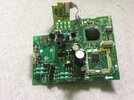Athosworld
Member
I have this telephone dock I teardowned and found that apparently, it is powered with 9 volts AC that seems to be rectified to DC.
There is something blobby going in the upper right, I decided to decap the chip.
The die photos:


There is something blobby going in the upper right, I decided to decap the chip.
The die photos:


